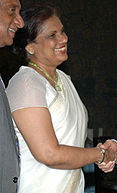Sri Lankan parliamentary election, 2004
|
|
|||||||||||||||||||||||||||||||||||||
|---|---|---|---|---|---|---|---|---|---|---|---|---|---|---|---|---|---|---|---|---|---|---|---|---|---|---|---|---|---|---|---|---|---|---|---|---|---|
|
|||||||||||||||||||||||||||||||||||||
|
All 225 seats to the Parliament of Sri Lanka 113 seats were needed for a majority |
|||||||||||||||||||||||||||||||||||||
| Turnout | 75.96% | ||||||||||||||||||||||||||||||||||||
|
|||||||||||||||||||||||||||||||||||||

Winners of polling divisions. UPFA in blue and UNF in green.
|
|||||||||||||||||||||||||||||||||||||
|
|||||||||||||||||||||||||||||||||||||
Ranil Wickremesinghe
United National Front
Mahinda Rajapaksa
United People's Freedom Alliance
Parliamentary elections were held in Sri Lanka on 2 April 2004. The ruling United National Party of Prime Minister Ranil Wickremesinghe was defeated, winning only eighty two seats in the 225-member Sri Lankan parliament. The opposition United People's Freedom Alliance won 105 seats. While this was eight seats short of an absolute majority, the Alliance was able to form a government.
On 6 April President Chandrika Kumaratunga commissioned Mahinda Rajapaksa, a former Labour Minister, as Prime Minister.
The United People's Freedom Alliance was formed as an alliance between President Kumaratunga's party, the Sri Lanka Freedom Party (SLFP), and the leftist Janatha Vimukthi Peramuna. Other parties that belong to the People's Alliance, such as the Communist Party of Sri Lanka, the Democratic United National Front, the Lanka Sama Samaja Party, Mahajana Eksath Peramuna and the Sri Lanka Mahajana Pakshaya, later joined UPFA.
In the 2001 elections, the People's Alliance and Janatha Vimukthi Peramuna had fought separately. Then the JVP won 9.1% of the vote and sixteen seats. At this election it is reported than as many as thirty nine JVP members won seats as UPFA candidates.
...
Wikipedia


